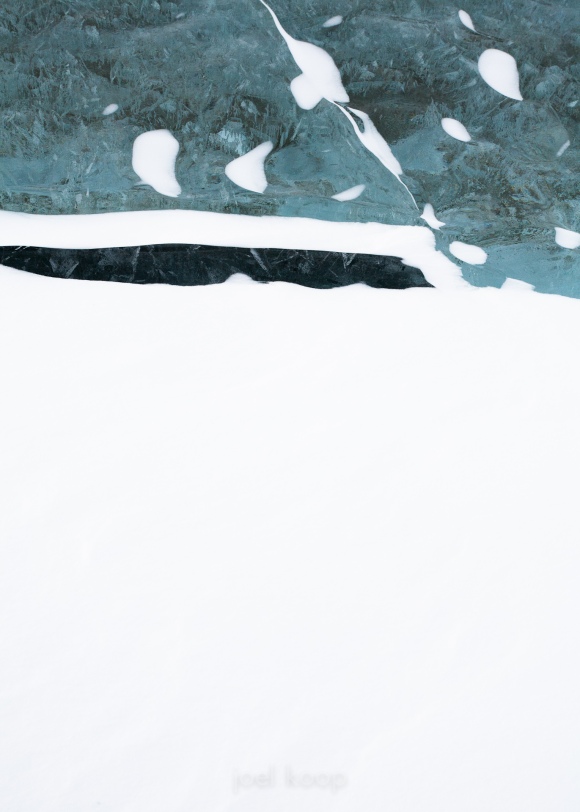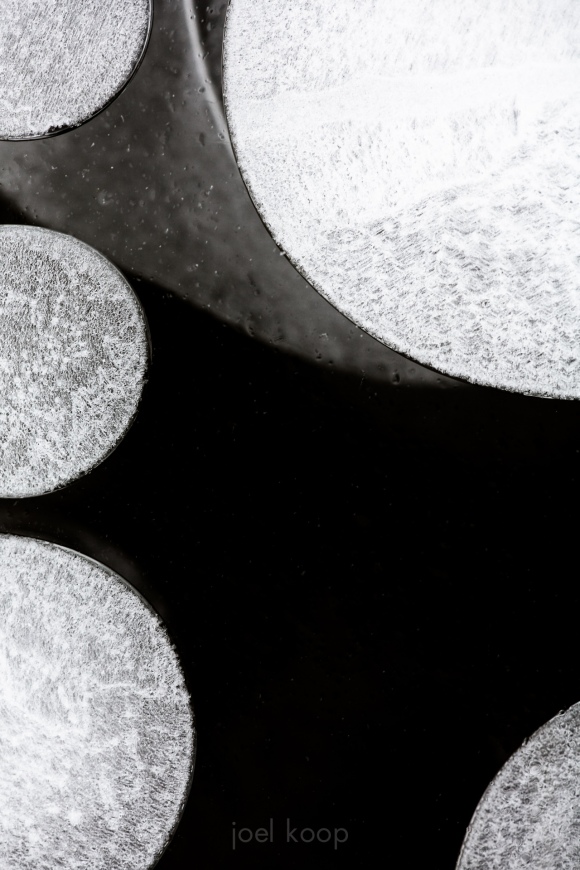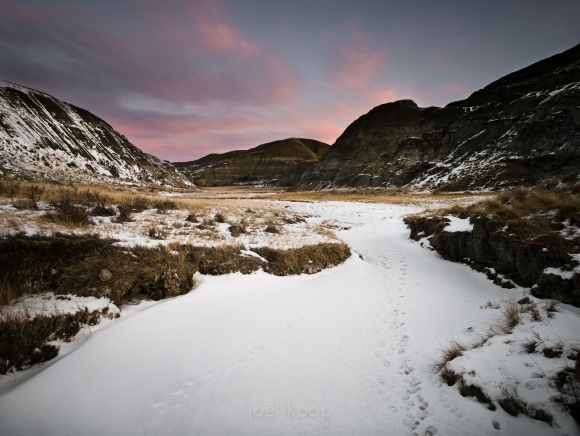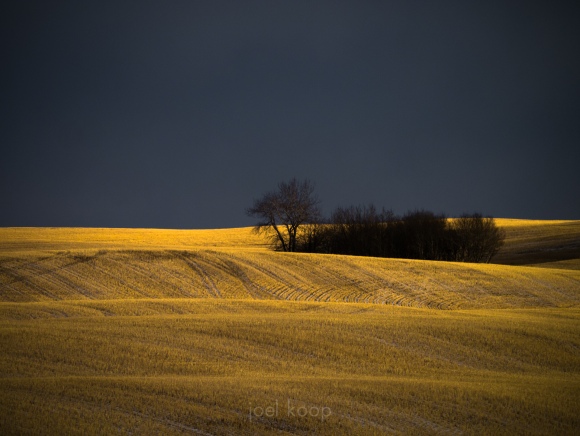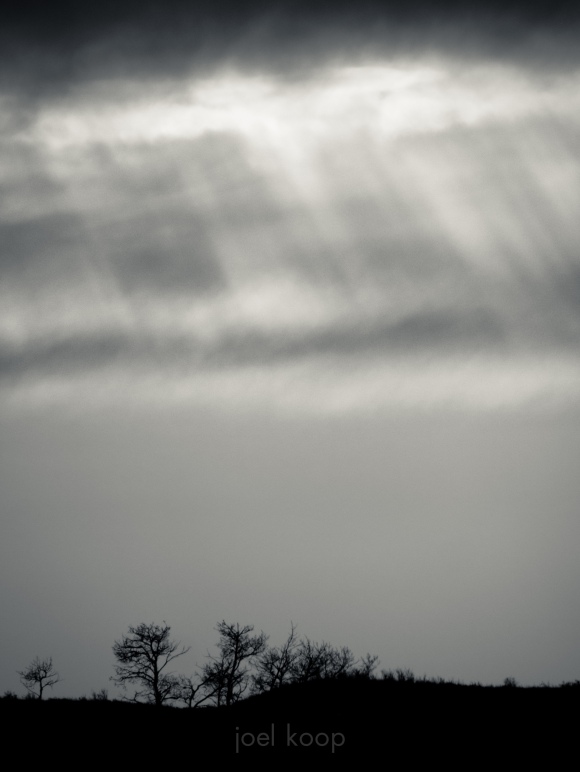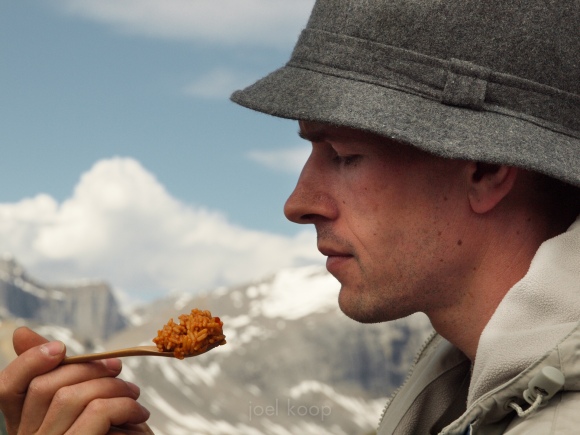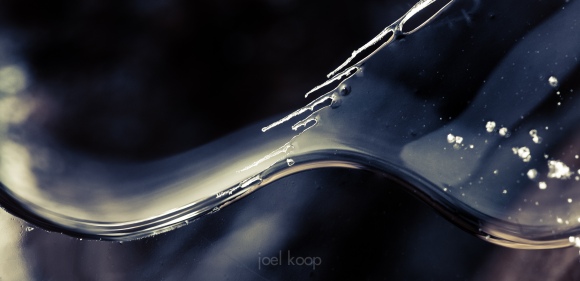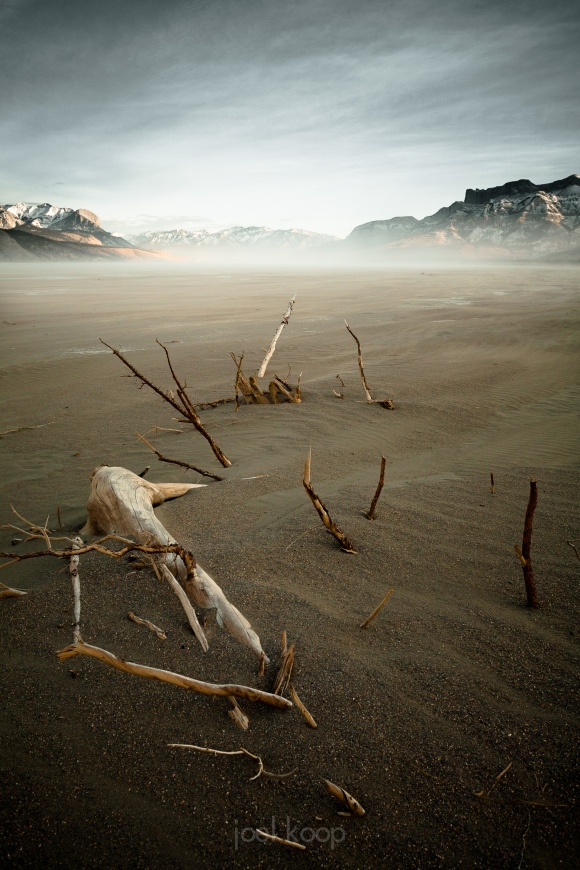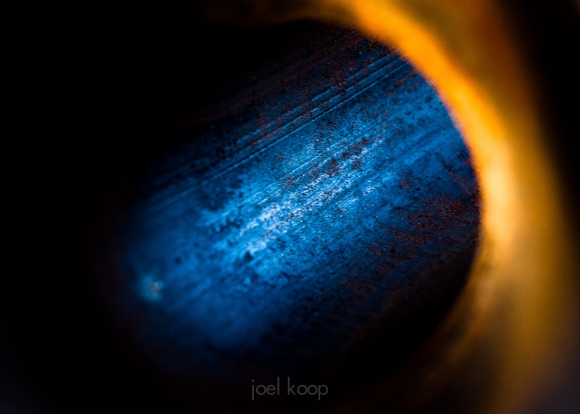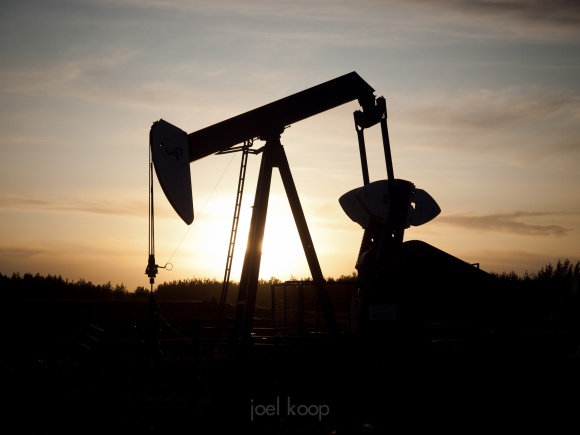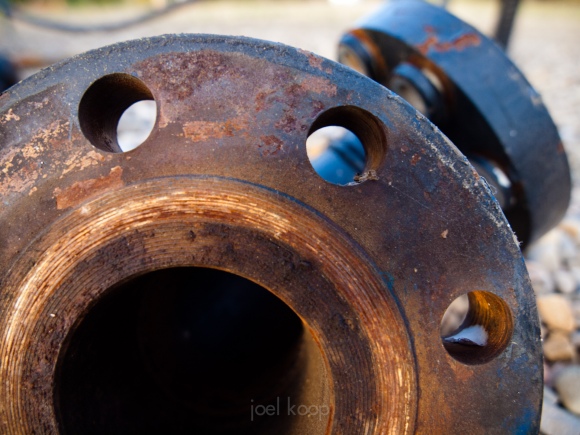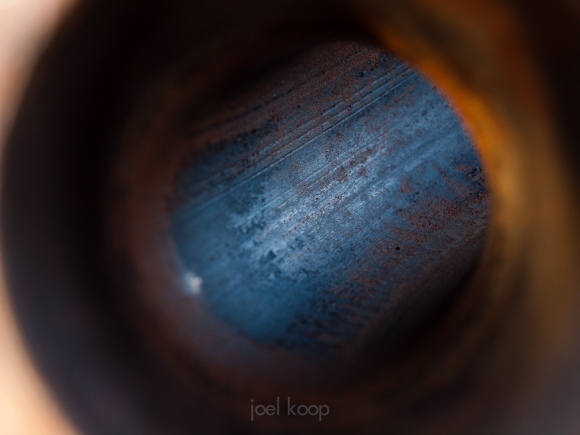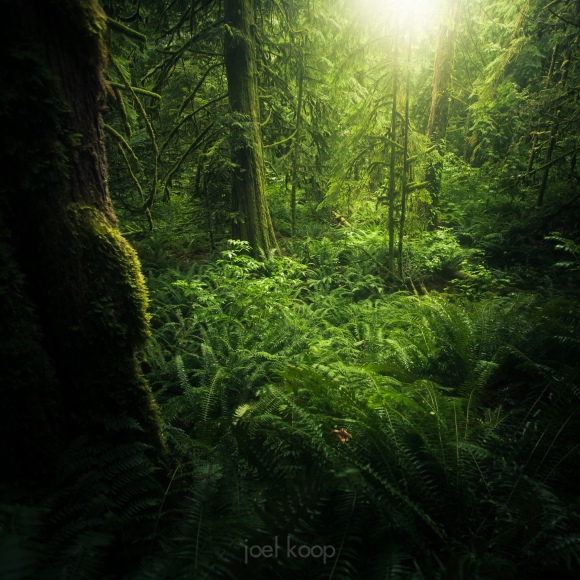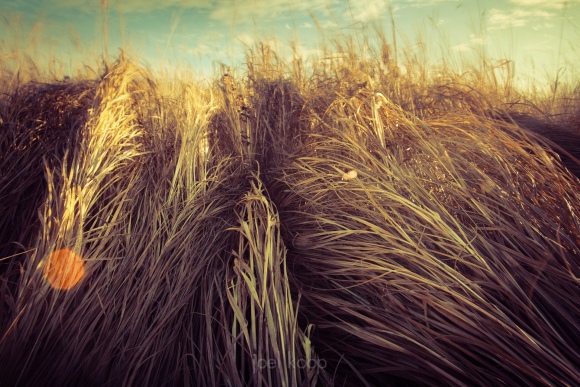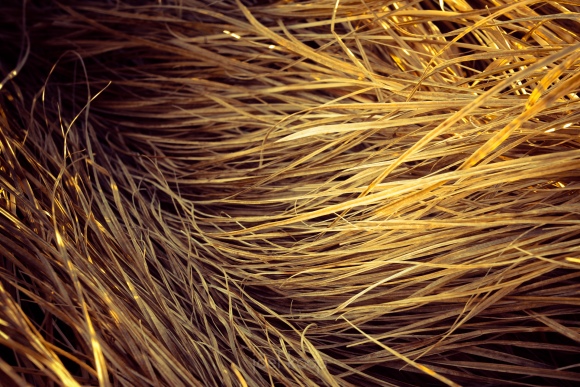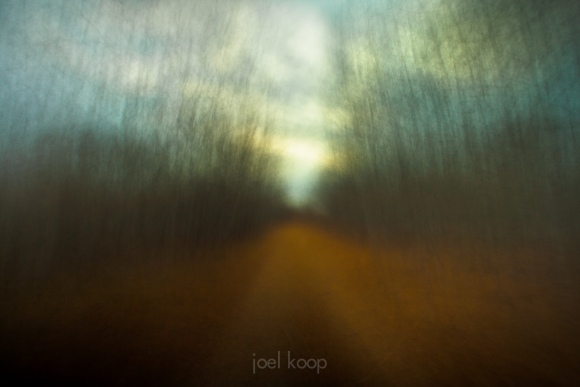In some ways this is very similar to my previous post. (You may need to click on the photo to see the entire photo more easily) This photo was taken very close to where the last one was on Abraham Lake. They are both abstract photos of nature using very strong design principles. They both play with positive and negative space, but instead of being very organic, this is very angular. The composition is almost entirely based on the rule of thirds — the dark line in the ice is about 1/3rd of the way down and protrudes about 2/3rds of the way into the photo. The ice in the photo covers about 1/3rd of the area, and the snow covers the other 2/3rds. This visual weighting based on the rule of thirds generally works very well, even if the dark and light areas of a photo are not seperated by a straight line (although here they are clearly seperated by a horizontal line). So, while the rule of thirds is almost over-popularized, it is still effective for creating interesting and new compositions.
Abstract Geometric Nature Photography
Finally starting to make my way through photos from the last few trips. This is from Abraham Lake, which has been extensively photographed by many Alberta landscape photographers. It’s easy to come up with the standard compositions here, but it’s also easy to come up with new stuff. There’s just so much variety in the ice, water and rocks. These are methane bubbles from decomposing organic matter. The bubbles form in the ice as the water freezes layer by layer.
In a shot like this, composition is everything. It has to balance the visual weight of light and dark. The three smaller bubbles on the left have to balance with the two larger bubbles on the right. The negative space and positive space both have to be interesting — here the textures in the ice and bubbles add visual interest. And because it’s nature and you can never control it completely, there will always be random elements to deal with. In this picture, the shadow of something deeper lies near the top of the frame. I like the visual reminder that in photography, art is created between the artist and the subject: you never have complete control.
Panasonic G1X Impressions
The Panasonic G1X is a great little camera. I got to use it for a short trip to Dinosaur Provincial Park a few weeks ago. I used it with the Olympus 12mm f2.0 prime, the old Panasonic 14-42mm kit lens, and Panasonic’s 100-300 telephoto lens. Carrying this kit was a welcome change from carrying around a Canon 5d with 4 fairly heavy lenses. I found the Panasonic very comfortable to use, and all the controls were well thought out. Not quite perfect, but no camera is. I was very curious to see if the image quality of this 4/3 sensor could get anywhere close to the 5d (a 7 year old full-frame digital slr).
Panasonic G1X with 14-42 lens
14mm, f9, 1/400 of a second
Remarkably, to me, it was close (it should be noted that I only shot raw photos, not JPGs). There is definitely a different characteristic look between a full-frame and a 4/3rds sensor, but that is not necessarily bad, just different. You get greater depth of field with the Panasonic, which I think accounts for much of this look. Dynamic range was surprisingly good from this little sensor — it didn’t seem to blow out highlights any quicker than my 5d. High iso pictures also looked better than I expected, and the grain, when it did show up, had a fairly pleasing quality to it.
12mm, f4.5, 1/40 of a second
Autofocus was a mixed bag. It is very fast, and I really enjoyed the touch screen to select autofocus points. The problem was that the autofocus areas are actually quite large, and you can’t tell what the camera is focusing on in that square. I did try the pinpoint autofocus mode, but it didn’t work that well for me. It could be that with further investigation and custom settings I could get this to work better.
Color was one of my biggest problems. Part of it is just getting used to the color response of a new camera — every camera is different, and this means that you have to process the colors differently. But the G1X didn’t seem to have the color depth I am used to from my 5d. It was actually quite similar to the Rebel XSi I had for a few months — I had trouble getting the color and color transitions to look the way I want. This meant desaturating some photos to get the colors to look good to my eye. I’m sure I could get more comfortable with this over time, but I’m also sure the colors are not quite as good as I’m used to. And I didn’t even get to try it with greens. Greens are my biggest problem color – trying to get greens to look natural to me can take many tries, even with the best cameras I’ve tried.
252mm, f6.3 1/500 of a second
My other complaint — and this really is the big one — is with the 100-300 lens. It is a sharp lens. It is a beautiful lens. The problem is stability with this long of a lens. WHY COULDN’T THEY PUT A COLLAR AND TRIPOD MOUNT ON IT???? This would fix everything. Putting a quick release plate on this camera works pretty well, but it is a small camera. The plate only has a small surface area that touches the camera, and this introduces some degree of instability. Add a relatively large lens like the 100-300 on the front and the tripod is now doing almost nothing. So this lens works fine for shooting at fast shutter speeds with bright light, but otherwise is useless. All because of the omission of a tripod mount.
275mm, f6.3, 1/4000 of a second
Small cameras have always been tempting to me. I don’t like carrying a lot of weight while I’m out hiking around, but image quality is most important to me, and at this point my old 5d is still a bit better. And new full-frame cameras (with even better quality sensors) are likely where I’ll be going once I can afford something new. But I do really like the trend towards small, light, fairly high-end cameras. I’m very curious to try out the Sony NEX-7, as this should be significantly better image quality and has an intriguing control layout.
So, is the G1X a good camera? Definitely. Is it a great camera? Possibly. Can it replace a full-frame camera for professional use? Not really, although I suppose that is obvious. Micro 4/3 is the most mature compact system at this point, with lots of good lens selection. But Sony’s NEX system has great cameras just waiting for lenses. And Fuji’s X-Pro1 looks fascinating. Things are changing fast.
Eating Cheaply on the Road
Not eating sandwiches, also — backpacking, not roadtripping
Olympus E-620 with 12-60 lens
48mm, F8, 1/1600 of a second
Sandwiches. This post could be that single word. But I’ll elaborate.
I go on road trips regularly, and I don’t have a lot of money. So I’ve had a lot of time to perfect this.
When I’m on a road trip I don’t want to spend lots of time eating — there’s much to see and places to go. Energy bars are quick, but they’re dry and not exactly a meal. Jerky tastes good every once in a while. Yogurt, fruit and fruit cups are great, but they’re not meals either. Lipton packs or other quick pasta packs are a hearty meal and taste good, but they require finding an appropriate place to set up a stove and a fair bit of time. Backpacker’s pantry and other add-water type meals are alright, but they’re outrageously expensive, and they still require that you get out a stove to boil water. At least you don’t need to wash dishes afterwards. And fast food, while convenient and occasionally yummy, is unhealthy, expensive, and requires you to be in a decent sized town when you’re hungry.
Sandwiches, however, are perfect. Every small town has a grocery store where you can pick up bread, cheese, mayo or miracle whip, and veggies (I like tomatoes and cucumbers). Generally, you can pick up enough for quite a few meals for not much money.
You can make sandwiches with very little preparation. A knife (and maybe a plate) is all that’s required. They only take a couple minutes to assemble, and they’re much healthier than fast-food. Clean-up afterward only requires wiping off the knife.
One little caveat. Sandwiches are great for road trips where you have a cooler — in summer it keeps everything cool, and in winter it keeps things from freezing. For backpacking, I’d worry about the mayo or miracle whip going bad. If anyone has suggestions for how to avoid this, that would be amazing. I’d leave out the spread, but then the sandwiches would be quite dry, and I can’t stand that. But when I’m backpacking I usually don’t mind taking longer to make a meal, and the Lipton packs are great for that.
Is Your Photography Art?
Ice on the Sunwapta River
Canon 5d with Sigma 150 macro
150mm, f5.6, 1/160 of a second
Lately I’ve been reading and thinking about the relationship between photography and art. It seems a lot of photographers define what they do as art and what many other photographers are doing as “not art”. Occasionally they try to soften it by saying that this is not a value judgement, but it’s impossible to remove that implication. Some say you have to pre-visualize the shot for it to be art, some claim there has to be a meaning, some claim that it has to involve creativity or originality. I say whether your work is art (or has artistic value) will not be decided by you. You only have a small amount of influence over the perception of your work. The best you can do is do what you love and let the chips fall where they may (unless you have an unusually large influence on a large number of people).
Guy Tal, a great inspiration and talented photographer, has been writing about photographers who go to commonly photographed natural icons and take photos similar to those taken thousands of times before. While I agree with most of his points (and I don’t find these photos very interesting), I think their value is not for me to decide. I tend to value the unusual (combined with beauty and/or story), as I think a lot of people do. The problem with valuing the unusual is that, for example, the rock arches in Utah are very unusual — until you’re looking at a photo that looks the same as 500 others you’ve seen. So even though 20,000 photos of this exact subject may exist, the first one you see will strike you as an incredible work of art. And as a photographer the same applies. If you haven’t seen a single photo of the arches before, you’re going to take one and think it’s incredible.
Unintended cliches are a common hazard for any artist. This is why it’s important, if you want to be considered an artist, to be aware of other work going on in your field. The problem of dishonesty is a much bigger issue. If a photographer is pretending their work is unique to an uneducated audience, then this is (possibly) a brilliant business strategy but has little to do with art. And of course trying to exactly copy another photographer’s picture and claim it as your own is completely unethical.
Artists over the centuries have stolen ideas, compositions, color schemes, and all sorts of things. This is common practice and good practice — as long as you have a unique perspective on it, ideally one that is recognizably yours. I’m constantly thinking about what defines my perspective (you do need an artist statement after all). While thinking about your perspective or statement is important, I’m not sure the conclusions are an essential part. In the end, your perspective will either show up in your work or it won’t, whether or not you’re aware of it. I think your perspective shows more when you feel free to be yourself than when you chase the idea of being someone else.
What I do is take photos that come from my own unique curiosity and interest in our world. I don’t plan this out (which may rule me out of the art world for some people). I don’t always make challenging political or societal statements with my photos. I take the photos that interest me most and that I enjoy taking. Other people can decide if it’s art — I’m too busy doing what I love (and editing that pesky artist statement).
After a Long and Barren Break
I’m finally back! With pictures! Happy New Year!
December was (as always) too busy, with far too little time for hiking and shooting. Thankfully I’m starting to recover, and last week I was able to go out to Jasper for a couple days, camp in the freezing weather, and completely enjoy it.
I also have some pendants back in stock after almost completely selling out at Christmas. I have many plans of updating websites and galleries, of taking lots of photos, of enabling online stores, and far too many more ideas to list here or ever complete. But I’ll work on stuff, and try to keep everyone updated.
Here’s a photo of a dry and dusty Jasper Lake from last week just after sunrise. I was getting blasted with a super cold wind, and even bundled up I had to run back to the shelter of the van after a few minutes.
Canon 5d with 17-40 lens.
Taken at 24mm, f8, 1/200 of a second
I’m planning to start adding these technical details below my photos. I know people are interested, and I’ve resisted for a long time because I believe they’re not really important. I think people place way too much emphasis on what the right settings are and way too little on getting a good composition. But to do photography well, you do have to at least know what all the settings do, and which are important in any particular instance. So for those learning, I hope this extra information helps, but know that the photo is the important part — the settings just help you get there. For example, I took this photo at f8. Would f5.6 have worked? Pretty well. Would f11 have worked. Yup, even a little better than f8. Did it ruin the photo that the aperture wasn’t as high as ideal to get everything perfectly in focus? Not at all, this will print beautifully at 20×30, and I’m really happy with it. Photography is about creating a feeling, not about an aperture. It would have mattered far more if I had angled my camera up or down a degree or two, or if I’d taken the photo from a foot lower or higher — those things could have easily turned it into something I wouldn’t look at twice.
At this point I think I’m rambling, and I’m impressed if anyone actually read this far. Cheers.
Abstract Oil Pipe Explained
At craft sales, I always have tags on the back of my photos with a title and short description. People seem to enjoy this, but sometimes a short tag is not enough. This photo, for instance, is only partially explained by the tag which says “Oilfield Remains”. So I often get questions, and I try to explain, but usually fail miserably. Well, here’s my (hopefully successful) explanation of the photo.
The story starts with me and Jason driving around the countryside finding nice things to take pictures of. This is a fairly common occurance in the life of a nature photographer. Oil rigs are also a fairly common occurance around Edmonton, so the two often coincide. We found this lovely oil rig just as the sun was setting, and of course I took the standard oil-rig-sunset shot which is the same as twenty billion other oil-rig-sunset shots. But hey, it gives me some context for the story.
Getting good photos means investigating things a little more, and while we’re wandering around the rig, we find (among other things) these random pieces of pipe on the ground. Rusty texture and curved lines catch my eye, and soon I’m down on the ground taking photos of this pipe elbow.
Well, in this photo there’s a bit too much going on for there to be a clear focal point, and the lines aren’t leading where they need to be leading. So I got a little closer, focused into the pipe, and took the photo you see at the top.
Green
Beaverhill Lake Grass
Warm sun and cool breeze: a beautiful fall day. The wind had matted the grass into interesting patterns in some places.
This was taken before all the snow hit. Looking out my window now, from the 12th floor, I can only see a couple blocks before the deluge of falling snow obscures everything. This snow would actually be perfect weather for photography but I really need to get winter tires on the van before I feel comfortable driving out to a natural area.
The Path Ahead
It’s all unclear, but beautiful.
Taken near Beaverhill Lake, AB.
Technical Note: I tried out a variable ND filter for the first time on this hike. ND (neutral density) filters block light, while otherwise (ideally) not affecting your image at all. This lets you have longer shutter speeds in bright light, which lets you blur subjects more easily. The above photo was a 4 second exposure.
The variable ND filter worked pretty well, but you have to be careful with ultra wide angle lenses. Like any polarizing filter, variable ND filters can create a dark stripe through your image if you use a wide angle lens, depending on the lighting.
